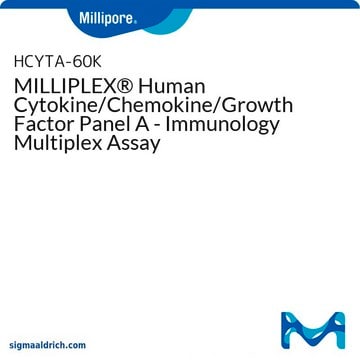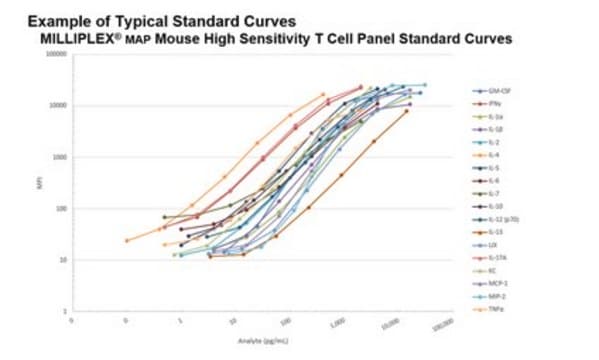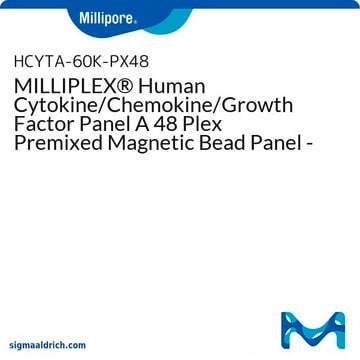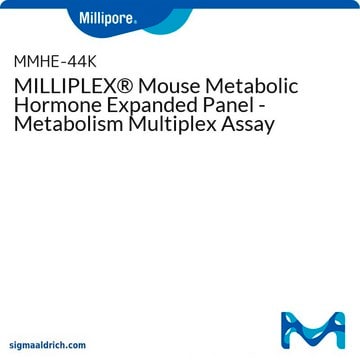Measurement of analytes in urine typically requires either a 24-hour urine collection or a second morning void collection. The analyte value is normalized against creatinine, meaning that the analyte is expressed as units/mg of creatinine.
MCYTOMAG-70K
MILLIPLEX® Mouse Cytokine/Chemokine Magnetic Bead Panel - Immunology Multiplex Assay
Simultaneously analyze multiple cytokine and chemokine biomarkers with Bead-Based Multiplex Assays using the Luminex technology, in mouse serum, plasma and cell culture samples.
Synonym(s):
Luminex® Mouse cytokine immunoassay, Millipore Mouse cytokine immunoassay, Mouse cytokine Multiplex Assay
About This Item
Recommended Products
Quality Level
species reactivity
mouse
manufacturer/tradename
Milliplex®
assay range
accuracy: 85-107%
standard curve range: 3.2-10,000 pg/mL
technique(s)
multiplexing: suitable
detection method
fluorometric (Luminex xMAP)
shipped in
wet ice
General description
- More flexible plate and plate washer options
- Improved performance with turbid serum/plasma samples
- Assay results equivalent to non- beads
- Automated washing avoids many problems associated with vacuum filtration washing
MILLIPLEX® Mouse Cytokine / Chemokine panel enables you to focus on the therapeutic potential of cytokines as well as the modulation of cytokine expression. Coupled with the Luminex® xMAP® platform in a bead format, you receive the advantage of ideal speed and sensitivity, allowing quantitative multiplex detection of dozens of analytes simultaneously, which can dramatically improve productivity.
Panel Type: Cytokines/Chemokines
Application
- Analytes: G-CSF, GM-CSF, IFN-γ, IL-1α, IL-1β, IL-2, IL-3, IL-4, IL-5, IL-6, IL-7, IL-9, IL-10, IL-12 (p40), IL-12 (p70), IL-13, IL-15, IL-17, IP-10, KC, LIF, LIX, MCP-1, M-CSF, MIG, MIP-1α, MIP-1β, MIP-2, RANTES, TNF-α, VEGF, Eotaxin/CCL11
Features and Benefits
Other Notes
Legal Information
Signal Word
Danger
Hazard Statements
Precautionary Statements
Hazard Classifications
Acute Tox. 4 Dermal - Acute Tox. 4 Inhalation - Acute Tox. 4 Oral - Aquatic Chronic 2 - Eye Dam. 1 - Skin Sens. 1 - STOT RE 2
Target Organs
Respiratory Tract
Storage Class Code
10 - Combustible liquids
Certificates of Analysis (COA)
Search for Certificates of Analysis (COA) by entering the products Lot/Batch Number. Lot and Batch Numbers can be found on a product’s label following the words ‘Lot’ or ‘Batch’.
Already Own This Product?
Find documentation for the products that you have recently purchased in the Document Library.
Customers Also Viewed
Related Content
Learn how immunoassays are used in cosmetics and personal care research to discover potential harmful effects of cosmetics products, and assess markers of inflammation, sensitization, aging, and tissue regeneration among others.
Learn how immunoassays are used in cosmetics and personal care research to discover potential harmful effects of cosmetics products, and assess markers of inflammation, sensitization, aging, and tissue regeneration among others.
Learn how immunoassays are used in cosmetics and personal care research to discover potential harmful effects of cosmetics products, and assess markers of inflammation, sensitization, aging, and tissue regeneration among others.
Learn how immunoassays are used in cosmetics and personal care research to discover potential harmful effects of cosmetics products, and assess markers of inflammation, sensitization, aging, and tissue regeneration among others.
-
Can the Cytokine Milliplex kits be used to measure cytokines in urine samples?
1 answer-
Helpful?
-
-
How should data that are below the detection limit be analyzed in the case of a Cytokine Milliplex kit where there are quite a few samples below the detection limit, causing the distribution to be non-normal? Should these data be input as "0.00" or should the lower detection limit be used as the value?
1 answer-
Most users will report the values as less than the manufacturer's limit of detection and then provide the sensitivity of each analyte in the Methods. Here are a couple of references as an example:
- Impact of telmisartan on the inflammatory state in patients with coronary atherosclerosis--influence on IP-10, TNF-α and MCP-1. Klinghammer L, Urschel K, Cicha I, Lewczuk P, Raaz-Schrauder D, Achenbach S, Garlichs CD. Cytokine. 2013 May;62(2):290-6.
- Plasma cytokine profiles in HIV-1 infected patients developing neuropathic symptoms shortly after commencing antiretroviral therapy: a case-control study. Van der Watt JJ, Wilkinson KA, Wilkinson RJ, Heckmann JM. BMC Infect Dis. 2014 Feb 10;14(1):71.
Helpful?
-
-
Can you confirm whether the detection antibodies of a multiplex kit are azide-free?
1 answer-
The detection antibody cocktail is not azide-free.
Helpful?
-
-
Which chemicals can cause bleaching of the Luminex beads?
1 answer-
The following solvents should not be used with Luminex microspheres as they will affect the classification dyes in the microspheres: Aromatic Hydrocarbons (Benzene, Toluene, Xylene, Ethylbenzene), Chlorinated aliphatic Hydrocarbons (Methylene chloride, Chloroform, Carbon tetrachloride), and Others (Pyridine, Dioxane, Dimethylformamide, Methyl ethyl ketone, Cyclohexanone, Tetrahydrofuran, N-butyl phthalate, Methyl phthalate, Ethyl phthalate, Tetrahydrofurfuryl alcohol, Ethyl acetate, Butyl acetate, 1-nitro-propane, Carbon disulfide, Tributyl phosphate, Cyclohexane, Methylcyclohexane, Ethylcyclohexane, Acetone, DMSO).
High salt concentrations will also affect the classification of the microspheres on the Luminex 200 and FLEX 3D; as the salt concentration of the buffer increases, the microspheres will tend to spread out the bead map. High salt buffers (6X SSC, >0.2M NaCL) should be diluted or exchanged prior to analysis as they can interfere with microsphere classification.
Helpful?
-
-
Do you have guidelines available for preparing human and mouse adipose tissue for use in the Milliplex kits to measure cytokine levels?
1 answer-
Our kits have not been validated for use with adipose tissue, although they can be used with various biological samples. Below are the guidelines for preparing adipose tissue:
- Approximately 4 g of adipose tissue from each subject should be homogenized in 16 ml of ice-cold homogenization buffer containing 10% glycerol, 150 mM NaCl, 2 mM EDTA, 1 mM PMSF, 25 mM benzamidine, 10 µM leupeptin, 2.5 µmol/liter pepstatin A, and 50 U/ml aprotinin in 10 mM Tris-HCl (pH 7.0), using a Polytron (Brinkmann Instruments, Inc., Westbury NY) with four up/down strokes at Setting No. 3.
- The crude homogenate should be centrifuged at 3,000 x g for 15 min, and the fat cake should be discarded. The homogenate should then be centrifuged again at 15,000 x g for 20 min at 4°C.
- The supernatant should be stored in aliquots at -80°C.The details provided are sourced from the Journal of Clinical Endocrinology & Metabolism Vol. 86, No. 12 5973-5980, authored by Xiangdong Wu, Johan Hoffstedt, Wasim Deeb, Reetu Singh, Natalia Sedkova, Assaf Zilbering, Li Zhu, Pauline K. Park, Peter Arner, and Barry J. Goldstein.
Helpful?
-
-
What is the maximum number of samples that can be processed in one plate of the Milliplex Luminex Mouse Cytokine kit (MCYTOMAG-70K)?
1 answer-
The Milliplex Luminex Mouse Cytokine kit (MCYTOMAG-70K) allows for processing 1 plate with 37 unknown samples and duplicates.
Helpful?
-
-
Is IL-18 for mouse available in the Milliplex kits?
1 answer-
IL-18 is available through the Custom Assay program under the Cat# SPRCUS889. It includes concentrated IL-18 Standard, concentrated IL-18 Beads, and concentrated IL-18 Detection Antibody. This can be spiked into MCYTOMAG-70K or MTH17MAG-47K. The IL-18 bead region (63) does not overlap with any regions in these 2 panels.
Helpful?
-
-
Could you provide information about the antibody specificity of IL-12p40 and IL-12p70?
1 answer-
The IL-12p40 antibody captures p40 on IL-12p40, IL-23, and is 30% cross-reactive to IL-12p70. For detection, it binds to p40 monomer, homodimer, and heterodimer, p35/p40. The IL-12p70 antibody, on the other hand, is specific to the p35 subunit and therefore only binds to IL-12p70. For detection, it binds to the p40 monomer, homodimer, and heterodimer.
Helpful?
-
-
Can you confirm or clarify whether the GRO antibody pair used in the Mouse Cytokine Panel 1 is a pan assay or specific to GRO1a?
1 answer-
The GRO antibody in the MCYTOMAG-70K panel is specific to GROa/CXCL1, also known as KC or CINC-1.
Helpful?
-
Active Filters
Our team of scientists has experience in all areas of research including Life Science, Material Science, Chemical Synthesis, Chromatography, Analytical and many others.
Contact Technical Service















